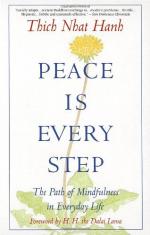
|
| Name: _________________________ | Period: ___________________ |
This test consists of 15 multiple choice questions and 5 short answer questions.
Multiple Choice Questions
1. What would have prevented the tremendous amount of destruction in Vietnam?
(a) An American vision of duality.
(b) A Vietnamese vision of non-duality.
(c) An American vision of non-duality.
(d) A Vietnamese vision of duality.
2. What technique discussed in "Cooking the Potato" transforms anger into a positive force?
(a) Meditation.
(b) Breathing.
(c) Mediation.
(d) Nurturing.
3. What should one do as angry feelings subside?
(a) Observe mindfully.
(b) Examine the source.
(c) Nurture the anger.
(d) Breathe consciously.
4. According to Hanh, what happens to anger when one pounds a pillow?
(a) It subsides temporarily.
(b) It becomes more intense.
(c) It subsides completely.
(d) It is negated.
5. Realistically, who can benefit from an individual's mindful living?
(a) Those who are suffering.
(b) The world.
(c) Relatives and close friends.
(d) People who are in daily contact.
6. What makes it more possible for one to sustain action for a worthy cause?
(a) The fruits of meditation.
(b) Wealth.
(c) Mindful living.
(d) The ability to be flexible.
7. What is Hanh's lament in "It is a Great Joy to hold Your Grandchild"?
(a) The Western cultures do not care for the elderly properly.
(b) Grandchildren are cared for by strangers.
(c) The Western cultures do not honor the elderly.
(d) Adult children minimize the importance of grandparents.
8. What facilities for gatherings does Hanh recommend for replacing the large family units?
(a) Community centers.
(b) Public gardens.
(c) Community libraries.
(d) Large churches.
9. According to Hanh, when must one recognize negative feelings?
(a) When they arise.
(b) When faced with a decision.
(c) When one has emotional support.
(d) Before they arise.
10. Which of these is NOT a component for the extension of mindful living into the world?
(a) Courage.
(b) Conscious breathing.
(c) Smiling.
(d) Awareness.
11. What simple practice should one do when anger begins to rise?
(a) Walking.
(b) Talking.
(c) Reading.
(d) Running.
12. What is the result of compassion towards another who is suffering?
(a) Eternal gratitude.
(b) Love and peace.
(c) Unconditional love.
(d) Joy and peace.
13. In the story "Look into Your Hand", who told the young man to look at his hand?
(a) Buddha.
(b) His mother.
(c) His father.
(d) His grandmother.
14. What term means "the essence of a person's true nature"?
(a) Ego.
(b) Interbeing.
(c) Dignity.
(d) Suchness.
15. What do negative feelings leave behind if they are not faced?
(a) Negativity.
(b) Relief, acceptance, and peace.
(c) Destructive feelings, thoughts, and behaviors.
(d) Positive acceptance.
Short Answer Questions
1. What does Hanh view as the best investment one can make?
2. Which of these dissolves anger?
3. What gift does holding a grandchild give to the grandparent?
4. What happens when one is cut off from nature?
5. What reason does Hanh give for the abuse of children at their own parents' hands?
|
This section contains 456 words (approx. 2 pages at 300 words per page) |

|




